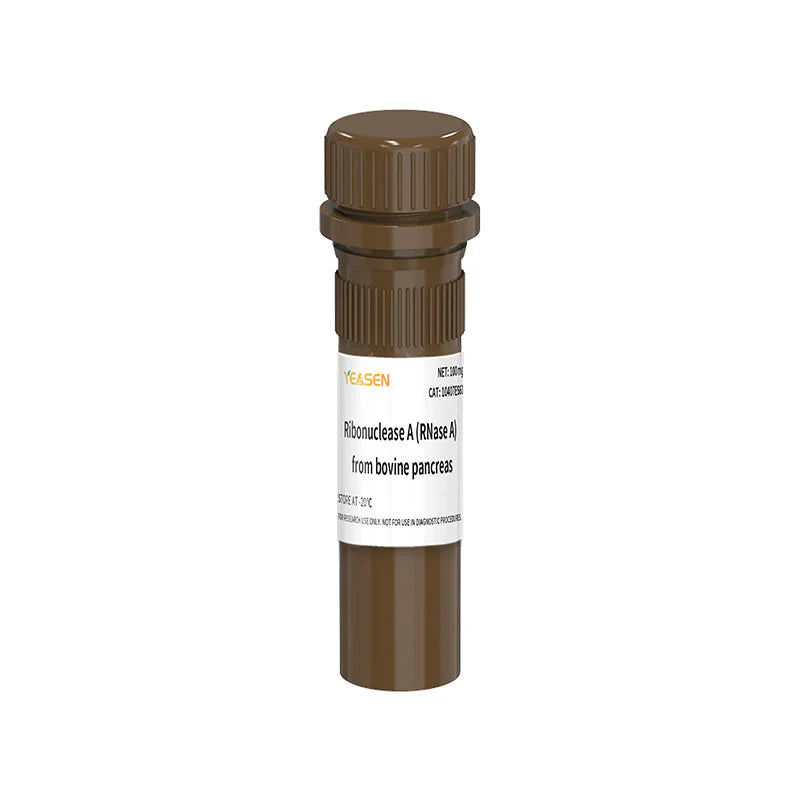Description
Ribonuclease A (RNase A) is a single-stranded polypeptide containing 4 disulfide bonds with a molecular weight of about 13.7 kDa. RNase A is an endoribonuclease that specifically degrades single-stranded RNA at C and U residues. Specifically, the cleavage recognizes the phosphodiester bond formed by the 5'-ribose of a nucleotide and the phosphate group on the 3'-ribose of the adjacent pyrimidine nucleotide, so that the 2', 3' - Cyclic phosphates are hydrolyzed to the corresponding 3'-nucleoside phosphates (eg, pG-pG-pC-pA-pG is cleaved by RNase A to generate pG-pG-pCp and A-PG).RNase A is the most active in cleaving single-stranded RNA .Recommended working concentration is 1-100 μ G/mL, compatible with various reaction systems. Low salt concentration (0-100 mM NaCl) can be used to cut single-stranded RNA, double-stranded RNA, and RNA chains formed by RNA-DNA hybridization. However, at high salt concentration (≥ 0.3 M), RNase A only specifically cleaves single-stranded RNA.
RNase A is most commonly used to remove RNA during the preparation of plasmid DNA or genomic DNA. Whether or not DNase is active during the preparation process can easily affect the reaction. The traditional method of boiling in a water bath can be used to inactivate DNase activity. This product does not contain DNase and protease, and does not require heat treatment before use. In addition, this product can also be used in molecular biology experiments such as RNase protection analysis and RNA sequence analysis.
This product is provided as a solution at a concentration of 100 mg/mL. The recommended working concentration is 1-100 μg/mL, depending on the type of application.
Features
Ribonuclease A (RNase A), from bovine pancreas
Activity ≥80 Kunitz U/mg
No DNase residue
Applications
RNases
Epitranscriptome Analysis
Genomic DNA Extraction & Purification
Specifications
|
Components No. |
Name |
10406ES03 |
|
10406 |
RNase A (100 mg/mL) |
1 mL |
Shipping and Storage
The product should be stored at -25°C ~ -15℃ for 2 years.
The preservation buffer was 50 mM Tris-HCl (pH 7.4) and 50% (V/V) glycerol.
Figures

Sample 1 has no RNase A,Sample 2-4 have added 1 μl of the 100 mg/mL RNase A. Then add 500 ng of RNA. After incubating at room temperature for 5 minutes, add 1 μl of 10X RNA loading buffer. Then load all the samples onto a 0.8% medium - pore agarose gel for electrophoresis at 160 V for 10 minutes.
Documents:
Safety Data Sheet
Manuals
10406_Manual_Ver. HB240703_EN.pdf
Citations & References:
[1] Chen Q, Xin M, Wang L, et al. Inhibition of LDHA to induce eEF2 release enhances thrombocytopoiesis. Blood. 2022;139(19):2958-2971. doi:10.1182/blood.2022015620(IF:23.629)
[2] Chen K, Guo T, Li XM, et al. Translational Regulation of Plant Response to High Temperature by a Dual-Function tRNAHis Guanylyltransferase in Rice. Mol Plant. 2019;12(8):1123-1142. doi:10.1016/j.molp.2019.04.012(IF:10.812)
Payment & Security
Your payment information is processed securely. We do not store credit card details nor have access to your credit card information.
Inquiry
You may also like
FAQ
The product is for research purposes only and is not intended for therapeutic or diagnostic use in humans or animals. Products and content are protected by patents, trademarks, and copyrights owned by Yeasen Biotechnology. Trademark symbols indicate the country of origin, not necessarily registration in all regions.
Certain applications may require additional third-party intellectual property rights.
Yeasen is dedicated to ethical science, believing our research should address critical questions while ensuring safety and ethical standards.

